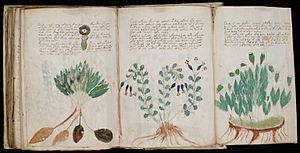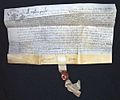Vellum facts for kids

Vellum is a special type of parchment. It is made from animal skin, usually calf skin. People used vellum for writing with ink, just like parchment. It was a main writing material in Europe before paper was common. Even after paper, vellum was used for important documents. It could be a single page, a scroll, or even a whole book.
Making vellum is a careful process. First, the animal skin is cleaned and bleached. Then, it's stretched on a special frame called a "herse." Workers scrape the skin with a knife, wetting and drying it to make it smooth and tight. Finally, they rub it with pumice (a light, rough stone) and treat it with lime or chalk. After all these steps, it is ready for ink.
Today, there's also "paper vellum." This is made from synthetic materials or cotton, not animal skin. It looks and feels a bit like real vellum and is used for similar purposes.
Contents
Vellum in the Past
In ancient Europe, vellum meant good quality prepared animal skin. Skins from calves, sheep, goat, and even camel were used. The very best vellum sometimes came from unborn animals. It can be hard to tell which animal was used for old vellum without special science tests.
In France, "velum" (or "velin") specifically meant vellum made only from calves. This idea has stayed true even today.
How Vellum Was Used
Many of the best medieval books were written on vellum. Some Buddhist texts were also written on it. All Sifrei Torah texts (Jewish holy scrolls) are still written on vellum or similar material.
When Johannes Gutenberg printed his first Gutenberg Bible in 1455, about a quarter of the 180 copies were on vellum. His customers likely expected this for such a high-quality book. Most other books at that time were printed on paper.
In art, vellum was used for paintings, especially if they needed to be sent far away. This was before canvas became popular around 1500. Vellum continued to be used for drawings and watercolours. Some Old master prints were also printed on vellum, especially for special copies, until at least the 1600s.
Book covers in the 1500s and 1600s often used soft vellum. Sometimes, these covers were decorated with gold. In later centuries, vellum was used more like leather. Vellum can be dyed almost any color. However, many people prefer its natural look, with its faint grain and hair marks.
Many important documents that needed to last a long time were written on vellum. This is because vellum lasts much longer than paper. Some vellum documents are over a thousand years old!
Modern Uses of Vellum
In the United Kingdom and the Republic of Ireland, official Acts of Parliament are still printed on vellum. This is for keeping them safe forever. Vellum is also still used for Jewish scrolls, fancy book covers, memorial books, and for special documents written in calligraphy.
Today, animal vellum is expensive and hard to find. This is because not many people need it, and it's complicated to make. Only one company in the UK still makes it. A modern alternative, called paper vellum, is made from cotton. This material is cheaper than animal vellum. You can find it in most art and craft stores. Some brands of writing paper also use the word "vellum" to suggest good quality.
In artistic crafts like writing, decorating, lettering, and bookbinding, "vellum" usually means calfskin. Other animal skins are called "parchment."
Paper Vellum
Paper vellum is made from cotton. It is usually see-through. Paper vellum comes in different sizes. It is often used for tracing, like for architectural plans. Just like real vellum, paper vellum is more stable than regular paper. This is important for making large drawings and plans, such as blueprints.
Storing Vellum
Vellum needs to be stored in a stable place with a steady temperature. If it's too dry (less than 11% humidity), it can become fragile and break easily. If it's too wet (more than 40% humidity), it can grow mold or fungus. The best temperature to keep vellum safe is around 20 °C (68 °F).
Images for kids
-
Magna Carta, a famous document written in Latin on vellum. It is kept at the British Library.
-
A Quran from the 7th century written on vellum.
See also
 In Spanish: Vitela para niños
In Spanish: Vitela para niños






